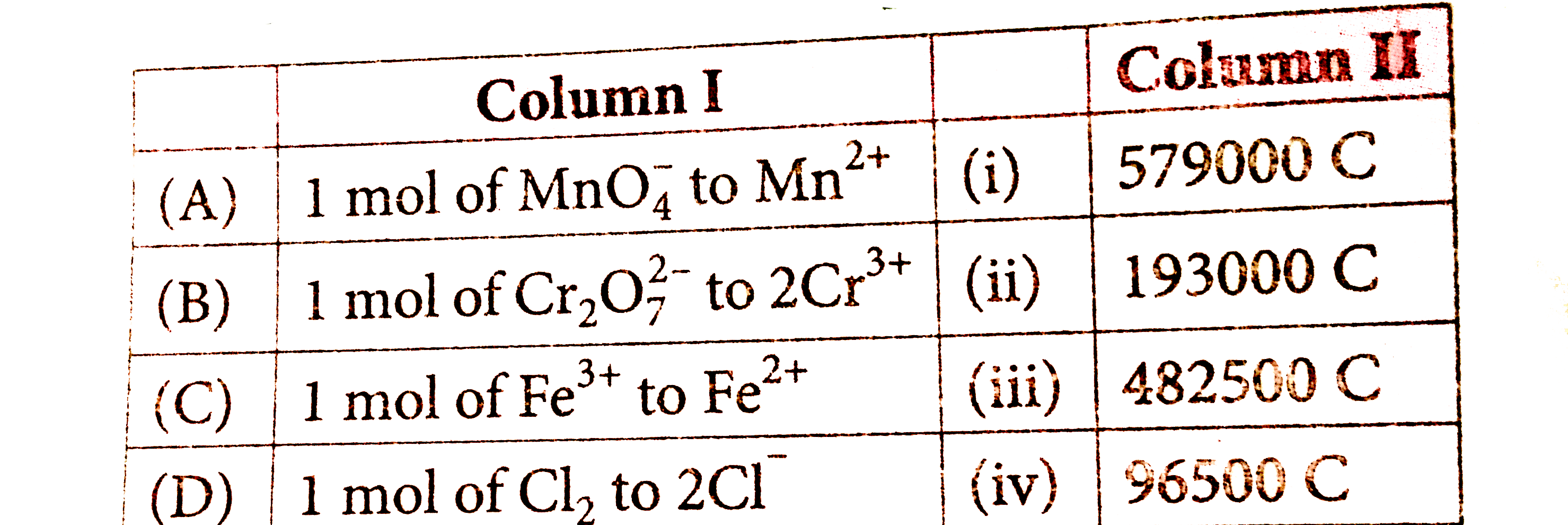The standard reduction potential for the half-cell reaction,Cl2+2e−→2Cl− will be (Pt2++2Cl−→Pt+Cl2,E∘cell=−0.15V,Pt2++2e−→Pt,E∘=1.20V)
−1.35V
+1.35V
1.05V
+1.05V
The correct Answer is:B
To solve the problem, we need to determine the standard reduction potential for the half-cell reaction:
Cl2+2e−→2Cl−
We are given two half-cell reactions with their standard reduction potentials:
1. Pt2++2Cl−→Pt+Cl2, with E∘cell=−0.15V
2. Pt2++2e−→Pt, with E∘=1.20V
Step 1: Reverse the first reaction
To find the standard reduction potential for the reaction involving chlorine, we first reverse the first reaction:
Pt+Cl2→Pt2++2Cl−
When we reverse a reaction, the sign of the standard potential changes. Therefore, the new potential becomes:
E∘=+0.15V
Step 2: Use the formula for cell potential
The standard cell potential E∘cell is given by the equation:
E∘cell=E∘cathode−E∘anode
In our case:
- The cathode reaction is the reduction of Cl2 to Cl− (which we are trying to find).
- The anode reaction is the reduction of Pt2+ to Pt.
Step 3: Substitute known values into the equation
From the given data:
- E∘anode=1.20V (for the Pt reaction)
- E∘cell=−0.15V (for the overall cell reaction)
Substituting these values into the equation gives:
−0.15=E∘cathode−1.20
Step 4: Solve for E∘cathode
Rearranging the equation to solve for E∘cathode:
E∘cathode=−0.15+1.20
E∘cathode=1.05V
Step 5: Conclusion
Thus, the standard reduction potential for the half-cell reaction Cl2+2e−→2Cl− is:
E∘=1.05V
2. Pt2++2e−→Pt, with E∘=1.20V
To find the standard reduction potential for the reaction involving chlorine, we first reverse the first reaction:
The standard cell potential E∘cell is given by the equation:
- The cathode reaction is the reduction of Cl2 to Cl− (which we are trying to find).
- The anode reaction is the reduction of Pt2+ to Pt.
From the given data:
- E∘anode=1.20V (for the Pt reaction)
- E∘cell=−0.15V (for the overall cell reaction)
Rearranging the equation to solve for E∘cathode:
E∘cathode=1.05V
Thus, the standard reduction potential for the half-cell reaction Cl2+2e−→2Cl− is:
Topper's Solved these Questions
- ELECTROCHEMISTRYBOOK - NCERT FINGERTPS ENGLISHCHAPTER - ELECTROCHEMISTRYEXERCISE - HOTS
10 Videos
- ELECTROCHEMISTRYBOOK - NCERT FINGERTPS ENGLISHCHAPTER - ELECTROCHEMISTRYEXERCISE - EXEMPLAR PROBLEMS
17 Videos
- COORDINATION COMPOUNDS BOOK - NCERT FINGERTPS ENGLISHCHAPTER - COORDINATION COMPOUNDS EXERCISE - Assertion And Reason
15 Videos
- GENERAL PRINCIPLES AND PROCESSES OF ISOLATION OF ELEMENTSBOOK - NCERT FINGERTPS ENGLISHCHAPTER - GENERAL PRINCIPLES AND PROCESSES OF ISOLATION OF ELEMENTSEXERCISE - Assertion And Reason
15 Videos
Similar Questions
The standard oxidation potentials, , for the half reactions are as follows :
Zn→Zn2++2e− ,E∘=+0.76V
Fe→Fe2++2e−,E∘=+0.41V
The EMF for the cell reaction,
Fe2++Zn→Zn2++Fe
View SolutionThe standard potential of the cell reaction Zn+Cl2→Zn2++2Cl− is 2.10V.Then the emf of the cell Zn∣∣Zn+2(0.05M)∣∣Cl−(0.2M)∣Cl2,Pt would be
View SolutionStandard reduction potentials of the half reactions are given below
F2(g)+2e−→2F−(aq)E∘=+2.85VCl2(g)+2e−→2Cl−(aq)E∘=+1.36VBr2(l)+2e−→2Br−(aq)E∘=+1.06Vl2(s)+2e−→2l−(aq)E∘=+0.53V
The strongest oxidising and reducing agents respectively are
View SolutionStandard reduction potentials of the half reactions are given below:
F2(g)+2e−→2F−(aq.),,Eɵ=+2.87
Cl2(g)+2e−→2Cl−(aq.),,Eɵ=+1.36V
Br2(g)+2e−→2Br−(aq.),,Eɵ=+1.09V
I2(s)+2e−→2l−(aq.),,Eɵ=+0.54V
The strongest oxidizing and reducing agents respectively are:
View SolutionStandard electrode potentials of few half-cell reactions are given below :
MnO−4+8H++5e−→Mn2++4H2OE∘=1.51VCr2O2−7+14H++6e−→2Cr3++7H2OE∘=1.33VFe3++e−→Fe2+E∘=0.77VCl2+2e−→2Cl−E∘=1.36
Based on the above information match the column I with column II and mark the appropriate choice.

View SolutionStandard reduction potentails of the half reactions are given below:
F2(g)+2e−→2F−(aq.),,Eɵ=+2.87
Cl2(g)+2e−→2Cl−(aq.),,Eɵ=+1.36V
Br2(g)+2e−→2Br−(aq.),,Eɵ=+1.09V
I2(s)+2e−→2l−(aq.),,Eɵ=+0.54V
The strongest oxidizing and reducing agents respectively are:
View SolutionDivide the following redox reactions into oxidation and reduction half reactions.
Cl2+2Br−→Br2+2Cl−
View SolutionThe standard reductino potentials Ec− for the half reactinos are as follows:
Zn→Zn2++2e− Ec−=+0.76V
Fe→Fe2++2e− Ec−=0.41V
The EMF for the cell reaction
Fe2++Zn→Zn2++Fe
is
View SolutionCalculate the electrode potential of the given electrode. Pt, Cl2(2 bar)| 2Cl–(0.02M); E°(Cl2∣2Cl–) = 3.4 V
View SolutionElectrode potential of the half Pt(s)|Hg(l)|Hg2Cl2(s)|Cl−(aq) can be incresed by :
View Solution
